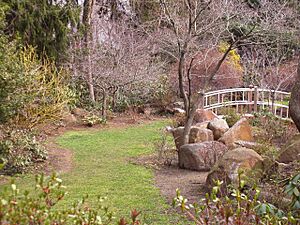Sayen Park Botanical Garden facts for kids
Sayen Park Botanical Garden, also called Sayen House and Gardens, is a beautiful park and botanical garden in Hamilton Township, New Jersey. It covers 30 acres, which is about the size of 20 football fields! You can visit the garden for free all year long, from sunrise to sunset. It's especially lively and colorful in the spring.
Contents
History of Sayen Park
The story of Sayen Park began in 1912. A man named Frederick Sayen and his wife, Anne Mellon, bought the land. They built a special house there called a "bungalow." This house had a unique style, mixing Arts and Crafts on the outside with Victorian designs inside.
The Sayens loved to travel the world. They brought back many different plants and flowers from their trips. These plants came from places like China, Japan, and England. They used these plants to create the amazing gardens around their home.
From Private Home to Public Park
In 1988, Hamilton Township bought the Sayen property. The township wanted to share this beautiful place with everyone. So, in 1991, Sayen Park was opened to the public. More improvements were made in 2003 to make the park even better.
Today, the garden is home to over 1,000 azalea plants and nearly 500 rhododendrons. In the spring, more than 250,000 flowering bulbs bloom, making the park burst with color! You can also find pretty ponds, charming bridges, cozy gazebos, and peaceful walking trails throughout the park.
Annual Azalea Festival
Sayen House and Gardens hosts a fun event every year called the Azalea Festival. This festival happens on Mother's Day. During the festival, the Sayen House is open for visitors to explore. You can visit the house from 10 AM to 4 PM on this special day.
Environmental Concerns at Sayen Park
In 2006, some news came out about the history of the Sayen House and Gardens site. Officials had been told in 1991, before the park opened, that the area might have been used for dumping. A company called Mercer Rubber Company, which used to be owned by the Sayen family, was located nearby.
Some people believed that this company had used the park land to dispose of waste materials for many years. There were concerns that a pipe might have carried waste from the company into a stream that ran through the park.
Investigations and Findings
Local residents noticed that some types of cancer seemed more common among people living near the park. Officials looked into these concerns. They found that certain types of cancer were indeed more common in the area. However, they could not directly prove that the waste from the Mercer Rubber Company caused these health issues.
Later, state officials met with residents. They explained that their studies about the site were not complete. For example, they had not tested the groundwater. They also did not include information from people who had moved away or those who had been diagnosed with cancer before 1979. These investigations aimed to understand the past use of the land and its possible effects.
See also
 In Spanish: Jardín botánico del parque Sayen para niños
In Spanish: Jardín botánico del parque Sayen para niños


